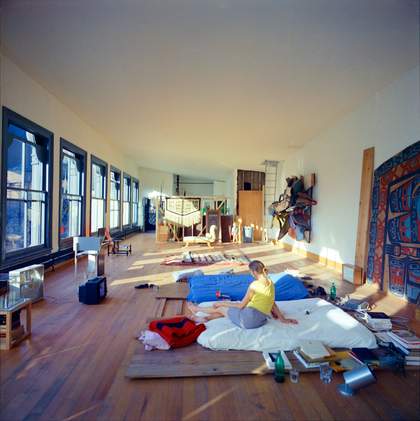
Julie Finch, Flavin Judd and Rainer Judd in the family bedroom on the fifth floor of 101 Spring Street, New York, 1970, photographed by Donald Judd
© Judd Foundation
The first piece of furniture Donald Judd made was his bed on the fifth floor of the large cast-iron building he bought in Spring Street, New York, in 1968. It is a simple platform of wooden boards that seems to float in space. A mattress sits on this island, almost like a canvas in a frame, covered with a tartan blanket that reflects the artist’s Scottish roots. A lamp and black telephone are close to hand. The piece is surrounded by artworks by his friends, Lucas Samaras, Claes Oldenburg and Dan Flavin, the last of whose light installation echoes the large windows that punctuate the generous room.
Judd’s pristine house is now open to the public, but photos from 1970 show his wife, the dancer Julie Finch, and their two children, Rainer and Flavin, in a more chaotic, domestic setting with towers of books, bottles and a TV. The dais holds two mattresses, as the children then slept alongside their parents.
This platform bed marked the beginning of Judd’s long engagement with furniture design. When he moved to Texas in 1977, after the disintegration of his marriage and in search of wide open spaces in which he might show permanent installations, he was disappointed by the furnishings available – ‘fake antiques or tubular kitchen furniture with plastic surfaces printed with inane geometric patterns and flowers’. He set about creating his own designs, and one of the first pieces he made was an unusual bed for his two young children, modelled on Frank Lloyd Wright’s at Taliesin with its day and night bed separated by a partition wall. Judd also designed his with a central dividing wall, and it was nailed together from pine planks cut to size at a nearby lumber yard, their width determining its dimensions.
The bed was made for the children’s room in a small house on the edge of town in which they lived while Judd built The Block, as his large walled compound in Marfa is known. ‘He split it down the middle and actually took the window and split it down the middle too, so we each got half,’ Rainer tells me. ‘And it was kind of neat because you could hang stuff on it, and throw stuff at each other over it.’ As they grew, he designed more pieces for them, such as school desks and chairs. Many of these were made by Judd’s father, a Western Union manager and son of a carpenter, who devoted himself to woodwork when he retired in 1968. Roy Judd also helped to realise many of Donald’s artworks.
In his 1993 essay It’s Hard to Find a Good Lamp, Judd tells the story of how, in the mid-1960s, a friend had asked him to create a coffee table, which he tried to do by adapting one of his artworks. He ended up destroying it, believing that to imitate art in design was to produce bad furniture and ‘debase’ the artwork – it was several years before he would try furniture design again. Though both his art and later furniture were made of the same materials, and fabricated with the same techniques, he always maintained that each operated on a different aesthetic: ‘The configuration and the scale of art cannot be transposed into furniture and architecture. The intent of art is different from that of the latter, which must be functional. If a chair or a building is not functional, if it appears to be only art, it is ridiculous.’
Judd considered most contemporary furniture ‘junk’. However, in the 1980s he built up a priceless collection of early 20th-century furniture. Much of this is displayed in Marfa’s former bank, a building that served as Judd’s architectural office. Alongside a standing desk and others of his own design, are pieces by Gerrit Rietveld, Marcel Breuer, Alvar Aalto, Piet Mondrian, Frank Lloyd Wright and Mies van der Rohe (his favourite furniture designer). They influenced his designs for chairs, shelves, desks, beds and tables in aluminium, steel, wood and copper that echo the formal purism of his sculptures.
The Judd Foundation continues to sell a capsule collection of wooden pieces, and his brightly coloured sheet metal furniture is still produced in Switzerland by Lehni AG. These industrial-looking creations are made up only of right angles, which he maintained was a reaction to Victorian ‘overstuffed bourgeois furniture’. They are not for lounging or any ill-defined seating position, but only assertive postures. ‘I am often told that the furniture is not comfortable and, in that, not functional,’ Judd grumbled. ‘The furniture is comfortable to me. A straight chair is best for eating and writing. The third position is standing.’ I ask his son Flavin what it was like being raised in this angular world. ‘Don’s world wasn’t angular,’ he replies. ‘It was just designed.’
Judd liked to mix his furniture and artworks, and is well known for his eccentricity of including beds in his private galleries, so that you could meditate and dream alongside the art. They fill each exhibition space with sexual frisson. ‘For Don, concentration on work was important,’ explains Flavin. ‘He put beds and places to sit all around his properties because they were all places to work. If he was in The Block and was thinking about a piece, he wanted to be able to stay there and think about it, even if that included a nap. The beds help to focus your mind on what you are thinking about.’
